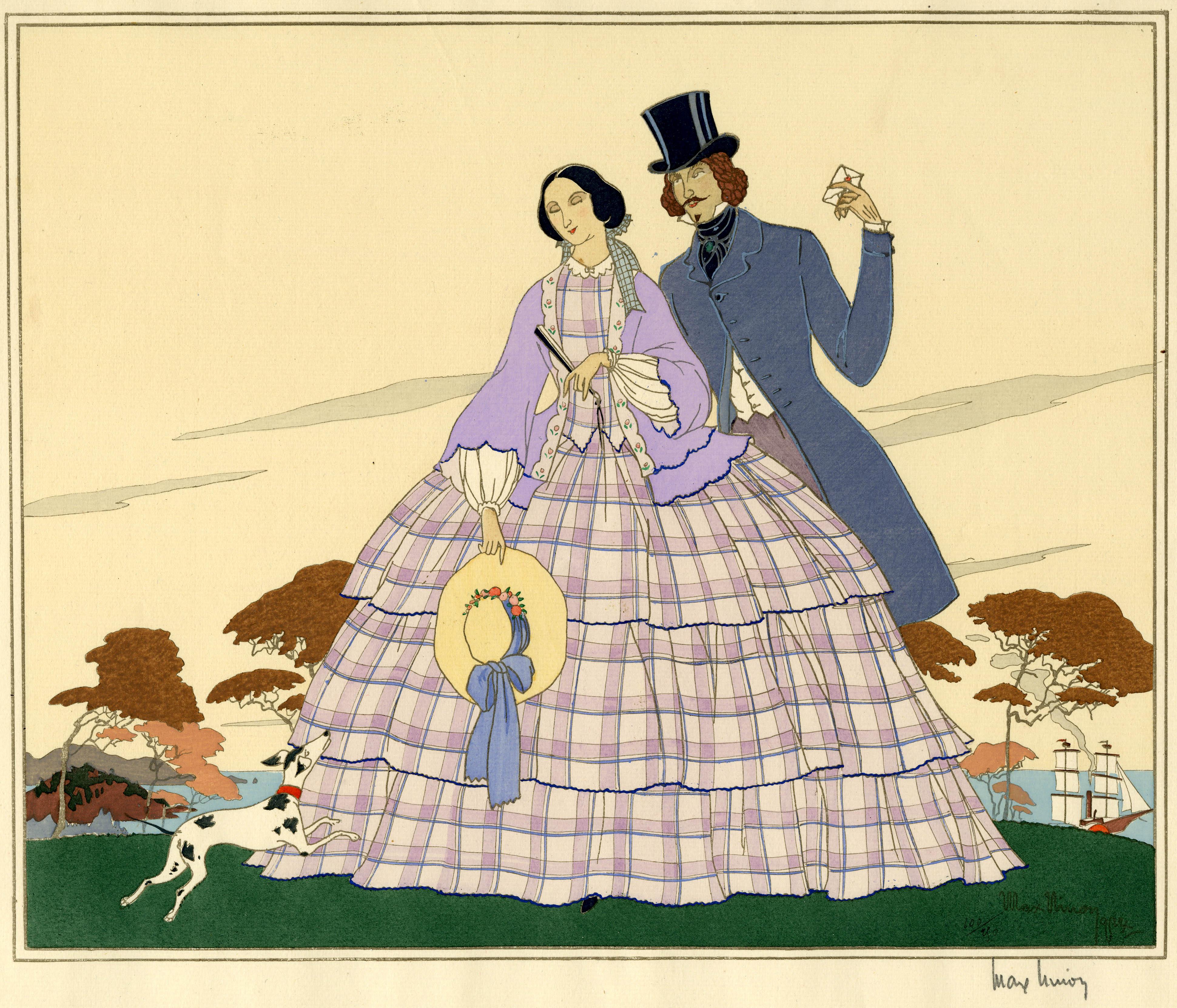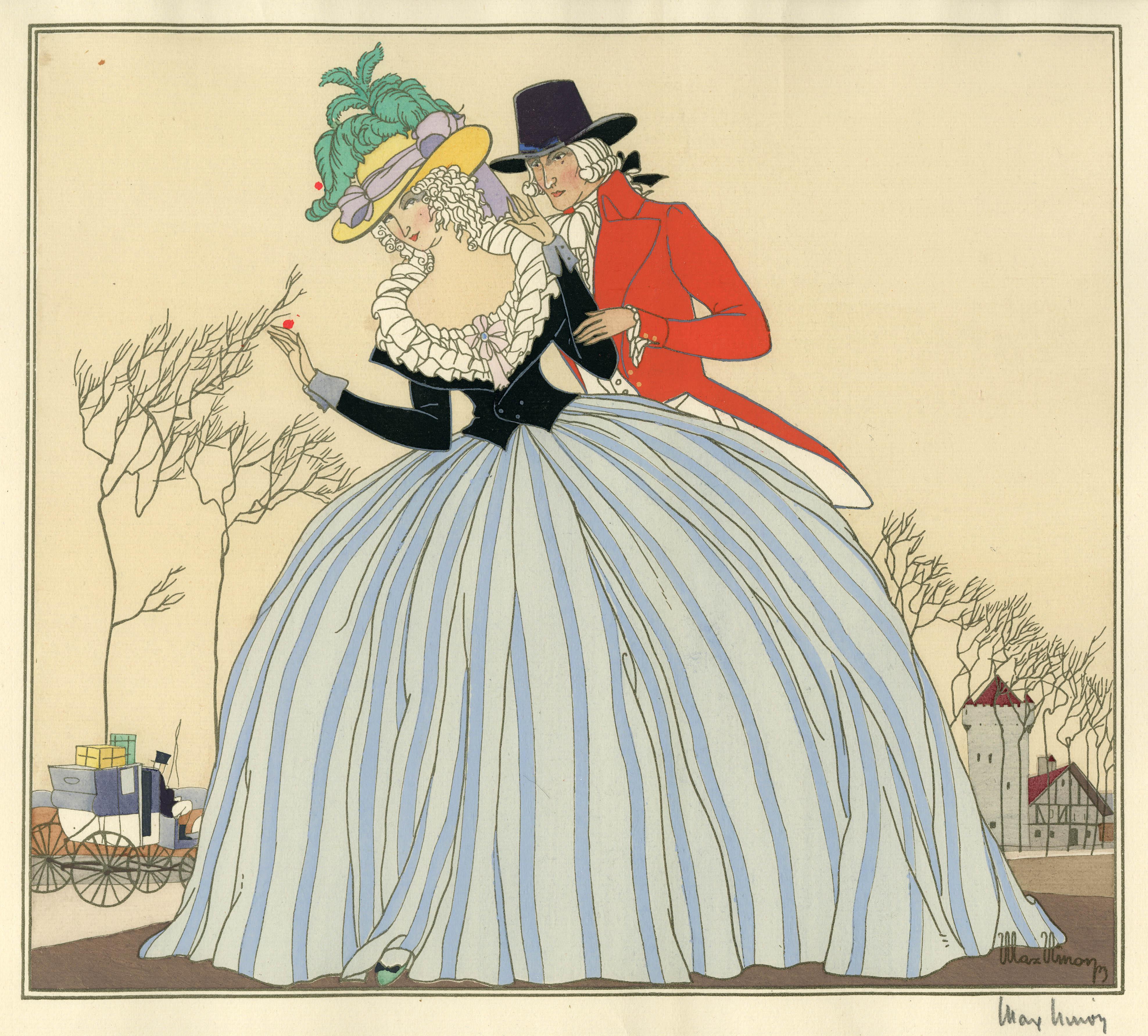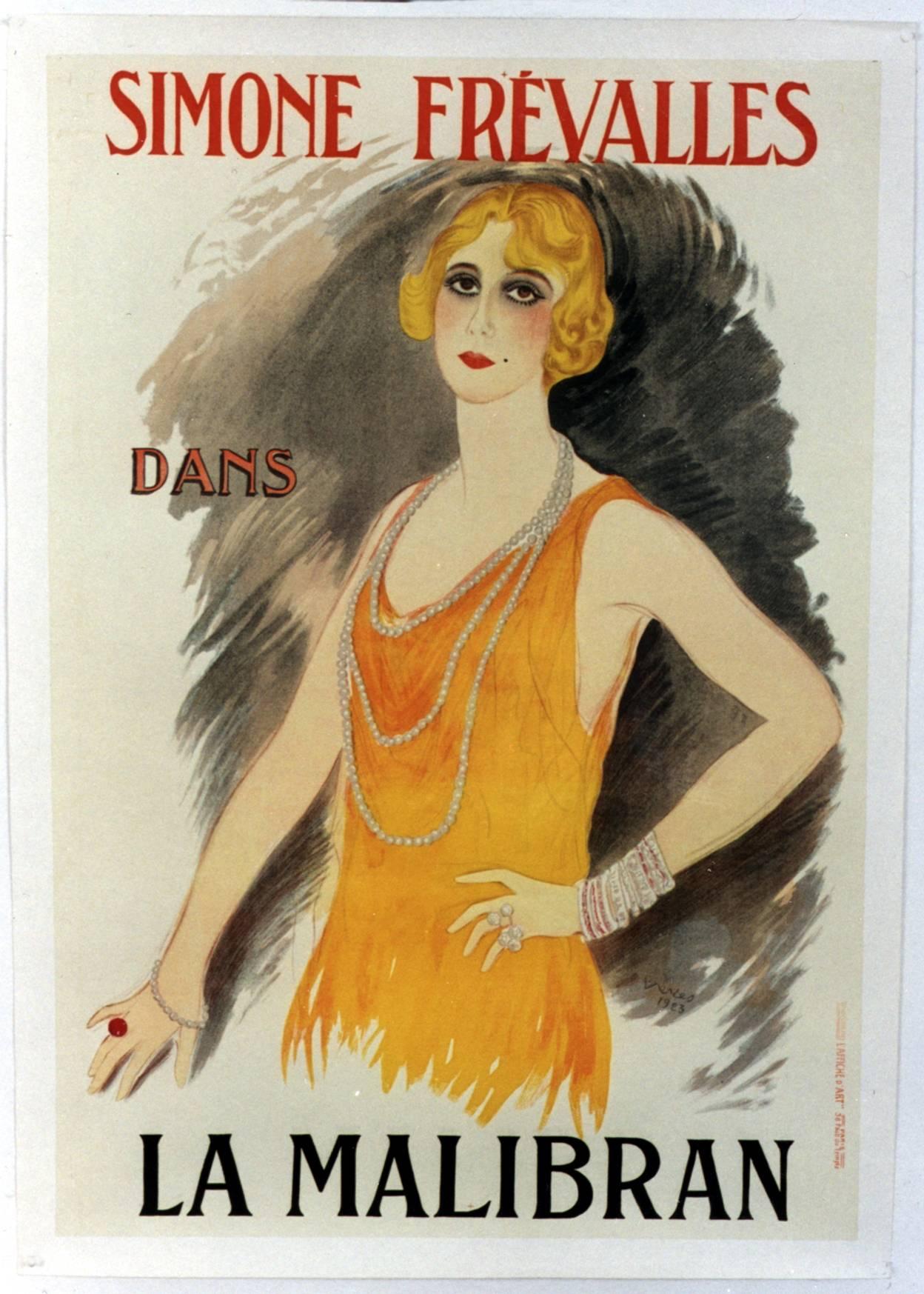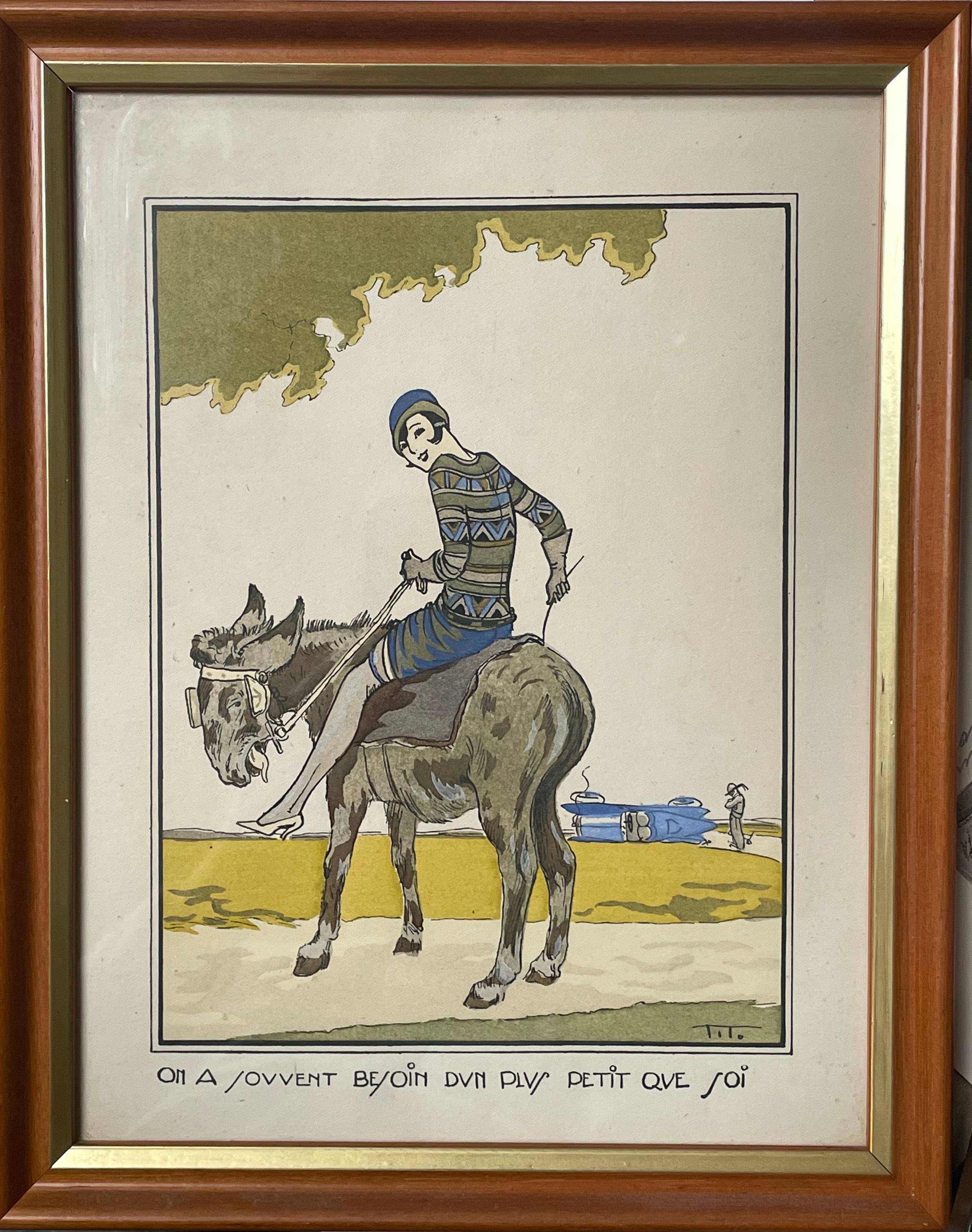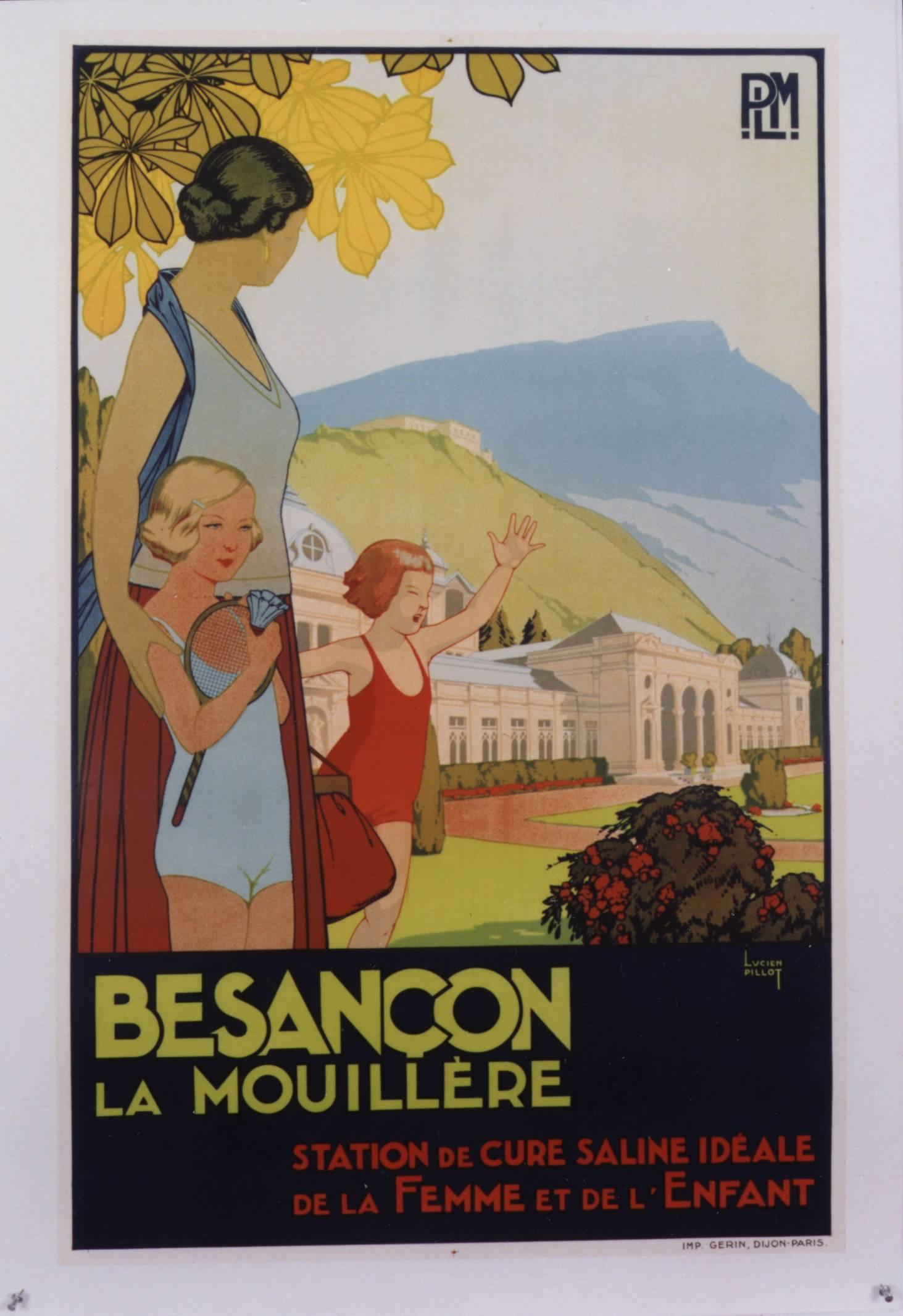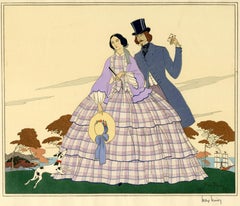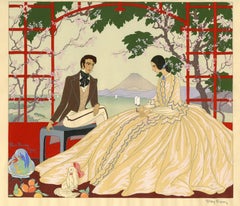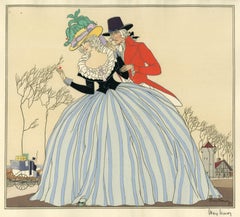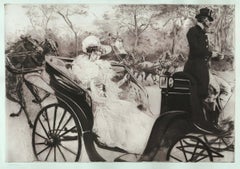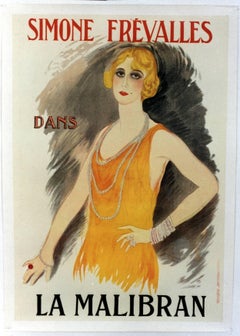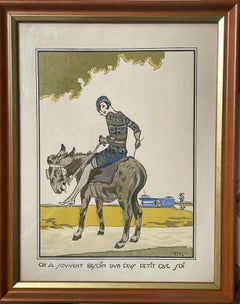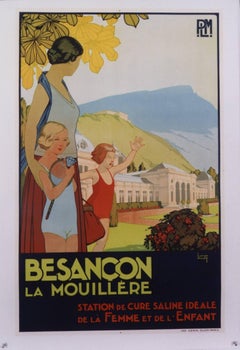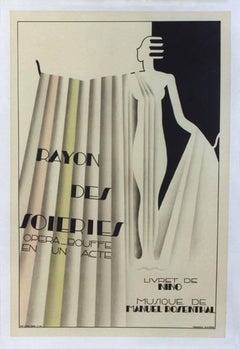Want more images or videos?
Request additional images or videos from the seller
1 of 13
Victor Max NinonEn Espagne1925
1925
$550
£419.64
€477.72
CA$773.03
A$849.75
CHF 446.11
MX$10,104.13
NOK 5,729.12
SEK 5,218.61
DKK 3,569.36
About the Item
En Espagne
Pochoir (silk screen) printed in colors
Signed by the artist in pencil lower right
The artist won a gold medal in Paris in 1925 for his pochoirs
Condition: Excellent
Image size: 11-1/2 x 13"
Sheet size: 19 1/2 x 24 3/4";
The artist won a gold medal in Paris in 1925 for his porchoirs
The artist is Italian, Vittorio Accornero de Testa, working in Paris.
The image combines Art Deco and Japonism, two of the most famous styles of the period of the 1920's.
Biography
Vittorio Accornero de Testa was born in Casale Monferrato in 1896. He completed his first studies at the "Leardi" institute, but was forced to interrupt them due to the war events of the First World War . At 19 he was second lieutenant of the Alpine troops and in 1916 he took one of the first pilot's licenses. During the war he knows the bitterness of shooting down in air combat (for which he is decorated), but also the good fortune to stay alive, albeit with a disability. His art blossomed in the postwar period, first signing his works simply Ninon and then, probably at the suggestion of a French publisher, under the pseudonym of "Victor Max Ninon" (Victor and Max indicate strength and masculinity, Ninon boyhood) .In 1919 and 1924 he made illustrations for theGiornalino della Domenica , also together with his first wife Edina Altara , for Ardita and La Lettura . In 1923 he won the cover competition organized by the magazine El Hogar of Buenos Aires and in 1925 with his pochoirs he imposed himself in Paris at the international exhibition of modern decorative and industrial arts , obtaining a gold medal. In the same year he made two covers for the US magazine The Smart Set . In the 1920s he made numerous series of art deco style postcards for the Milanese publishing house Degami . On June 4, 1929, aGenoa embarks on the Conte Grande together with his wife Edina Altara , for New York . The two stayed in the American metropolis for a few months: in this period Accornero worked on the creation of theatrical sets and created some covers for Country Life magazine . Accornero gets awards and prizes, but the great economic crisis of the time and the nostalgia for Italy convince the two to return to their homeland, where they resume their activity as illustrators.
In 1934 Accornero moved to Milan, separated amicably from his wife and continued to dedicate himself to the illustration of children's books, abandoning the pseudonym Victor Max Ninon. It illustrates about 60 books, from the fables of Andersen , Perrault and Grimm , to the tales of Poe , as well as the famous Pinocchio and Cuore published by Mondadori, Mursia, Hoepli, Martello. Several books illustrated by Accornero have been published in French, Spanish, German and English. In addition to the periodicals already mentioned, he collaborates on the first edition of the Encyclopedia of Boys , Mondadori, and with the Italian magazines Lidel , Il Secolo XX, The Italian Illustration , Fantasies of Italy , The Woman , Cordelia , For You Lady , Grace , Metropolis , La Domenica del Corriere , The Corriere dei Piccoli .
In 1936 enters the world of cinema, creating sets and costumes for Wedding Vagabonde of Guido Brignone and The White Squadron of Augustus Genina . From 1935 to 1950 he also devoted himself to the theater, taking care of sets and costumes for numerous operettas, ballets and performances at the Scala in Milan and for the Milanese theaters Manzoni, Lirico and Olympia. Stages Marcello di Giordano, Nina pazza d'amore by Paisiello, I cantori di Nurimberga by Wagner, La Bohème by Puccini and other works. For this activity he is also cited in the Theater encyclopedia.
In the 1940s and 1950s he wrote and illustrated six books for children for Mondadori: Tomaso (1944), Giacomino (1949), Tomaso Cacciatore (1950), Zio Stefano (1950), In Campagna che delizia! (1953), Tomaso, dear Tomaso (1955). His illustrations of Perrault's Tales published in those years by Hoepli are famous.
His art in the fifties evolves towards hyperrealism . There are many personal exhibitions in Italy and abroad, including those at the Gallerie Gussoni (1959) and Bolzani (1963 and 1966) in Milan and Walcheturm (1962) in Zurich. Eminent critics praise his work, from Orio Vergani to Enrico Piceni, from Reto Roedel to De Chirico himself. On the Domenica del Corriere , the journalist, writer and painter Dino Buzzati wrote two pages on the Accornero exhibitions of 1959 [1] and 1963.
From 1960 to 1981 he collaborated with Gucci , designing about 80 foulards , including the very famous Flora, made in 1966 for Grace Kelly . A rich selection of these scarves was exhibited in Sassari in August 2009, in the premises of the Frumentaria, on the occasion of the exhibition "Giardini di Seta - Vittorio Accornero's scarves for Gucci".
He died in Milan in 1982.
Courtesy of Wikipedia
- Creator:Victor Max Ninon (1896-1982, Italian)
- Creation Year:1925
- Dimensions:Height: 11.5 in (29.21 cm)Width: 13 in (33.02 cm)
- Medium:
- Movement & Style:
- Period:
- Condition:Never matted or framed Original condition.
- Gallery Location:Fairlawn, OH
- Reference Number:Seller: FA60051stDibs: LU14015849392
About the Seller
5.0
Recognized Seller
These prestigious sellers are industry leaders and represent the highest echelon for item quality and design.
Gold Seller
Premium sellers maintaining a 4.3+ rating and 24-hour response times
Established in 1978
1stDibs seller since 2013
835 sales on 1stDibs
Typical response time: <1 hour
Associations
International Fine Print Dealers Association
- ShippingRetrieving quote...Shipping from: Fairlawn, OH
- Return Policy
More From This Seller
View AllCoquette
By Victor Max Ninon
Located in Fairlawn, OH
Coquette
Pochoir (silk screen) printed in colors, c. 1923-1925
Signed by the artist in pencil lower right; numbered in ink on the image, (see photo)
Edition: 250 (100/250) in pencil in image (see photo)
Image size: 10-1/2 x 12-3/4"
The artist won a gold medal in Paris in 1925 for his porchoirs
Victor Max Ninon (Vittorio Accornero de Testa, Italian, 1896-1982)
Biography
Vittorio Accornero de Testa was born in Casale Monferrato in 1896. He completed his first studies at the "Leardi" institute, but was forced to interrupt them due to the war events of the First World War . At 19 he was second lieutenant of the Alpine troops and in 1916 he took one of the first pilot's licenses. During the war he knows the bitterness of shooting down in air combat (for which he is decorated), but also the good fortune to stay alive, albeit with a disability. His art blossomed in the postwar period, first signing his works simply Ninon and then, probably at the suggestion of a French publisher, under the pseudonym of "Victor Max Ninon" (Victor and Max indicate strength and masculinity, Ninon boyhood) .In 1919 and 1924 he made illustrations for theGiornalino della Domenica , also together with his first wife Edina Altara , for Ardita and La Lettura . In 1923 he won the cover competition organized by the magazine El Hogar of Buenos Aires and in 1925 with his pochoirs he imposed himself in Paris at the international exhibition of modern decorative and industrial arts , obtaining a gold medal. In the same year he made two covers for the US magazine The Smart Set . In the 1920s he made numerous series of art deco style postcards for the Milanese publishing house Degami . On June 4, 1929, aGenoa embarks on the Conte Grande together with his wife Edina Altara , for New York . The two stayed in the American metropolis for a few months: in this period Accornero worked on the creation of theatrical sets and created some covers for Country Life magazine . Accornero gets awards and prizes, but the great economic crisis of the time and the nostalgia for Italy convince the two to return to their homeland, where they resume their activity as illustrators.
In 1934 Accornero moved to Milan, separated amicably from his wife and continued to dedicate himself to the illustration of children's books, abandoning the pseudonym Victor Max Ninon. It illustrates about 60 books, from the fables of Andersen , Perrault and Grimm , to the tales of Poe , as well as the famous Pinocchio and Cuore published by Mondadori, Mursia, Hoepli, Martello. Several books illustrated by Accornero have been published in French, Spanish, German and English. In addition to the periodicals already mentioned, he collaborates on the first edition of the Encyclopedia of Boys , Mondadori, and with the Italian magazines Lidel , Il Secolo XX, The Italian Illustration , Fantasies of Italy , The Woman , Cordelia , For You Lady , Grace , Metropolis , La Domenica del Corriere , The Corriere dei Piccoli .
In 1936 enters the world of cinema, creating sets and costumes for Wedding Vagabonde of Guido Brignone and The White Squadron of Augustus Genina . From 1935 to 1950 he also devoted himself to the theater, taking care of sets and costumes for numerous operettas, ballets and performances at the Scala in Milan and for the Milanese theaters Manzoni, Lirico and Olympia. Stages Marcello di Giordano, Nina pazza d'amore by Paisiello, I cantori di Nurimberga by Wagner, La Bohème by Puccini and other works. For this activity he is also cited in the Theater encyclopedia.
In the 1940s and 1950s he wrote and illustrated six books for children for Mondadori: Tomaso (1944), Giacomino (1949), Tomaso Cacciatore (1950), Zio Stefano (1950), In Campagna che delizia! (1953), Tomaso, dear Tomaso (1955). His illustrations of Perrault's Tales published in those years by Hoepli are famous.
His art in the fifties evolves towards hyperrealism . There are many personal exhibitions in Italy and abroad, including those at the Gallerie Gussoni (1959) and Bolzani (1963 and 1966) in Milan and Walcheturm (1962) in Zurich. Eminent critics praise his work, from Orio Vergani to Enrico Piceni, from Reto Roedel to De Chirico himself. On the Domenica del Corriere , the journalist, writer and painter Dino Buzzati...
Category
1920s Art Deco Figurative Prints
Materials
Stencil
Au Japon
By Victor Max Ninon
Located in Fairlawn, OH
Au Japon
Pochoir (Stencil Print), 1925
Signed by the artist in pencil lower right (see photo)
Signed in the image lower left (see photo)
Stamped verso: Made in France
Note: The artis...
Category
1920s Art Deco Figurative Prints
Materials
Screen
Robe Grise
By Victor Max Ninon
Located in Fairlawn, OH
Robe Grise
Pochoir (silk screen) printed in colors, 1923
Signed by the artist in pencil lower right (see photo)
The artist won a gold medal in Paris in 1925 for his pochoirs
Condition: Two spots in the upper left corner associated with the printing.
Victor Max Ninon (Vittorio Accornero de Testa, Italian, 1896-1982)
Biography
Vittorio Accornero de Testa was born in Casale Monferrato in 1896. He completed his first studies at the "Leardi" institute, but was forced to interrupt them due to the war events of the First World War . At 19 he was second lieutenant of the Alpine troops and in 1916 he took one of the first pilot's licenses. During the war he knows the bitterness of shooting down in air combat (for which he is decorated), but also the good fortune to stay alive, albeit with a disability. His art blossomed in the postwar period, first signing his works simply Ninon and then, probably at the suggestion of a French publisher, under the pseudonym of "Victor Max Ninon" (Victor and Max indicate strength and masculinity, Ninon boyhood) .In 1919 and 1924 he made illustrations for theGiornalino della Domenica , also together with his first wife Edina Altara , for Ardita and La Lettura . In 1923 he won the cover competition organized by the magazine El Hogar of Buenos Aires and in 1925 with his pochoirs he imposed himself in Paris at the international exhibition of modern decorative and industrial arts , obtaining a gold medal. In the same year he made two covers for the US magazine The Smart Set . In the 1920s he made numerous series of art deco style postcards for the Milanese publishing house Degami . On June 4, 1929, aGenoa embarks on the Conte Grande together with his wife Edina Altara , for New York . The two stayed in the American metropolis for a few months: in this period Accornero worked on the creation of theatrical sets and created some covers for Country Life magazine . Accornero gets awards and prizes, but the great economic crisis of the time and the nostalgia for Italy convince the two to return to their homeland, where they resume their activity as illustrators.
In 1934 Accornero moved to Milan, separated amicably from his wife and continued to dedicate himself to the illustration of children's books, abandoning the pseudonym Victor Max Ninon. It illustrates about 60 books, from the fables of Andersen , Perrault and Grimm , to the tales of Poe , as well as the famous Pinocchio and Cuore published by Mondadori, Mursia, Hoepli, Martello. Several books illustrated by Accornero have been published in French, Spanish, German and English. In addition to the periodicals already mentioned, he collaborates on the first edition of the Encyclopedia of Boys , Mondadori, and with the Italian magazines Lidel , Il Secolo XX, The Italian Illustration , Fantasies of Italy , The Woman , Cordelia , For You Lady , Grace , Metropolis , La Domenica del Corriere , The Corriere dei Piccoli .
In 1936 enters the world of cinema, creating sets and costumes for Wedding Vagabonde of Guido Brignone and The White Squadron of Augustus Genina . From 1935 to 1950 he also devoted himself to the theater, taking care of sets and costumes for numerous operettas, ballets and performances at the Scala in Milan and for the Milanese theaters Manzoni, Lirico and Olympia. Stages Marcello di Giordano, Nina pazza d'amore by Paisiello, I cantori di Nurimberga by Wagner, La Bohème by Puccini and other works. For this activity he is also cited in the Theater encyclopedia.
In the 1940s and 1950s he wrote and illustrated six books for children for Mondadori: Tomaso (1944), Giacomino (1949), Tomaso Cacciatore (1950), Zio Stefano (1950), In Campagna che delizia! (1953), Tomaso, dear Tomaso (1955). His illustrations of Perrault's Tales published in those years by Hoepli are famous.
His art in the fifties evolves towards hyperrealism . There are many personal exhibitions in Italy and abroad, including those at the Gallerie Gussoni (1959) and Bolzani (1963 and 1966) in Milan and Walcheturm (1962) in Zurich. Eminent critics praise his work, from Orio Vergani to Enrico Piceni, from Reto Roedel to De Chirico himself. On the Domenica del Corriere , the journalist, writer and painter Dino...
Category
1920s Art Deco Figurative Prints
Materials
Stencil
La Promenade
By Edgar Chahine
Located in Fairlawn, OH
La Promenade
Etching, soft-ground, aquatint & drypoint,
Signed in pencil lower left
Published by Edmund Sagot, Paris
Edition of 50 in black only, aside from the edition of 50 in co...
Category
Early 1900s Art Nouveau Figurative Prints
Materials
Drypoint, Etching, Aquatint
Preliminary drawing for Remy de Gourmont, Couleurs, (Colors, new tales follow...
By Jean-Emile Laboureur
Located in Fairlawn, OH
Preliminary drawing for Remy de Gourmont, Couleurs, published in Le Mercure de France
(Colors, new tales follow old things), 1908
Graphite and colored pencil, 1926
Signed in pencil l...
Category
1920s Art Deco Figurative Drawings and Watercolors
Materials
Color Pencil
Preliminary drawing for Remy de Gourmont, Couleurs, (Colors, new tales follow...
By Jean-Emile Laboureur
Located in Fairlawn, OH
Preliminary drawing for Remy de Gourmont, Couleurs, published in Le Mercure de France
(Colors, new tales follow old things), 1908
Graphite and colored...
Category
1920s Art Deco Figurative Drawings and Watercolors
Materials
Color Pencil
You May Also Like
Simon Frevalles
By Marcel Vertès
Located in New York, NY
Poster Adverting the Entertainer Simon Frevalles. 1923. Color lithograph. On Linen.
An outstanding twentieth century painter, printmaker and illustrator, Marcel Vertes moved from his native Hungary to Paris during the First World War. The art of Marcel Vertes was at its peak during the vibrant and somewhat wild decade of the 1920’s. Concentrating upon scenes of Paris street life, portrayals of women and depictions of circus and cabaret acts, Vertes left a legacy of original lithographs and drawings that superbly capture the spirit of 1920’s Paris.
Vertès is also responsible for the original murals in the Café Carlyle...
Category
1920s Art Deco Figurative Prints
Materials
Lithograph
Ettore Tito (1859-1941) - On a Souvent Besoin.... Art Deco Pochoir Print
By Ettore Tito
Located in Edinburgh, GB
Art Deco original pochoir print.
Please find the dimensions of the artwork:
20 x 15 cm - Dimensions of the image
26 x 20 cm - Dimensions of the paper
28 x 22,5 cm - Framed dimensi...
Category
Early 20th Century Art Deco Figurative Prints
Materials
Paper
Besancon La Mouillere PLM
By Lucien Pillot
Located in New York, NY
Besancon La Mouillere PLM. Ca 1930. printed by Gerin Paris
Color lithograph. On Linen
Lucien Pillot registered as a member of the Société des Artistes Français. He had previo...
Category
1930s Art Deco Figurative Prints
Materials
Lithograph
Rayon des Soieries
By Maurice Dufrêne
Located in New York, NY
DuFrene, Maurice. Rayon des Soierie
Ref: Opera, 17; Publisher: Imp. Chaix, Pairs.
Maurice Dufrene was born in Paris in 1876.
He studied at the Ecole des Arts Decoratifs, and to...
Category
1920s Art Deco Figurative Prints
Materials
Lithograph
L'Andalouise au Temps des Maures
By Jules Chéret
Located in Spokane, WA
Original L'Andalouise au Temps des Maures vintage art nouveau poster.
L'Andalousie au Temps des Maures. Exposition de 1900.
Imprimerie C...
Category
1890s Art Nouveau Portrait Prints
Materials
Lithograph
$2,920 Sale Price
20% Off
Original Spain Stiges vintage travel poster linen-backed
Located in Spokane, WA
Josep (Jose) Morell is a name that often surfaces in discussions of mid-century Spanish travel and poster art, particularly in the context of Catalan tourism campaigns. While there i...
Category
1940s Art Deco Landscape Prints
Materials
Lithograph
More Ways To Browse
En France
International Exhibition Of Modern Decorative And Industrial Arts
Antique Amore
Picasso Dejeuner
Picasso Gravure
Picasso King
Picasso Letter
Picasso Lithograph Horses
Picasso Non Vouloir
Picasso Picador Et Taureau
Picasso Satyr
Pierre Bonnard Signed
Pkz Posters
Rare Vintage Original Skate Decks
Rembrandt Etching Amsterdam
Renoir Hand Signed
Roger Jourdain
Rouault Passion
